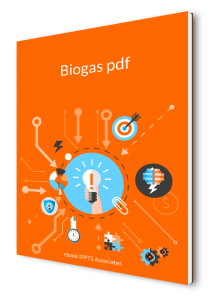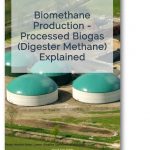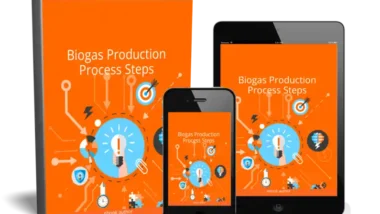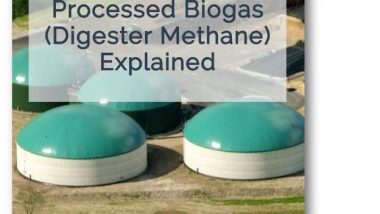Download our Biogas pdf below. It’s NEW and it’s free!
 11 pages of fresh new information on biogas for all those interested including students.
11 pages of fresh new information on biogas for all those interested including students.
Newbie friendly!
No prior knowledge of the biogas process is needed.
Table Of Contents
- Introduction
- Biogas Technology Advance – Biomethane
- Biogas Reducing Air-Pollution
- Landfill Biogas
- Biogas is Renewable
- Biogas is Created from Non-Food Crop Materials and Predominantly
- Biogas Made from Waste Materials
- Why Estimates of Potential Biogas Energy Output Will Keep Rising
- Biogas Purification in More Detail
- The Outlook for Biogas
- Conclusion
Download your pdf (eBook) below:
To view this file you will need the free Acrobat Reader application.
All I ask is that when every person who downloads this pdf shares this page on their Twitter, Linked In, or Facebook. Thank you.
For those who prefer to read a web page the document is also copied below:
The biogas pdf defines and explains biogas and its potential.
Biogas is primarily methane (CH4) and carbon dioxide (CO2) and may have small amounts of hydrogen sulphide (H2S), moisture and siloxanes. It’s a renewable energy source.
For our Legal Disclaimer: See the bottom of this page.
Introduction
Biogas is considered to be a renewable resource because its production-and-use cycle is continuous, and it is perfectly possible for it to be used without generating net carbon dioxide emissions to the atmosphere. After all, using it to power man’s existence will only be resulting in CO2 emissions which were going to end up in the atmosphere anyway, through natural degradation. So, in effect using biogas has zero net emissions.
Until now it has mostly been used for heating and creating electricity, and the most popular has been to use a reciprocating internal combustion engine, such as GE Jenbacher or Caterpillar gas engines to generate electrical power.

Biogas Technology Advance – Biomethane
However, in the last 5 years, a new biogas purification technology (called upgrading) has been developed that allows the biogas to be cleaned so that it can be used interchangeably with the natural gas piped to many households. Biogas that are clean can also be used to power vehicles as well.
With the ability of the purified biogas, which is called biomethane, to be a vehicle fuel it was also realized that biomethane is a near-perfect fuel that burns clean and has a far lower air polluting emission than diesel fuel. It was not long before people were saying. “Why use biogas to generate electricity when there are plenty of other ways to create renewable energy for electricity, such as solar panels and wind turbines”.

Biogas Reducing Air-Pollution
Why do that, when we could be curing the vastly unhealthy air problems of almost every city on the planet, by using biomethane instead of diesel?
To make it clearer just how clean/ low emission transport vehicles become when using biomethane, just think of this!
The air pollution produced by biogas is similar to that of natural gas.
Yes. Almost none!
Natural gas is a gas which we burn in our cookers, hotplates, and central heating boilers every day. We have no concerns about breathing that, for all our lives, nor should we because the air remains clean. Contrast that with the exhaust fumes visible from diesel vehicles, even just the small as a big lorry passes…
Over the next 10 years, it seems very likely that the use of it as a vehicle fuel will become much more common, and that combustion it in biogas generators to make electricity will become quite rare.

Landfill Biogas
Biogas is not only produced in anaerobic digestion plants (digesters). It is also naturally produced in landfill sites as bacteria anaerobically break down our rubbish, but normally the methane escapes into the atmosphere where it contributes to global warming.
Just like in a bio-digester, in landfills biogas is produced using organic material, which is broken down with the help of bacteria in an anaerobic (oxygen-free) environment. The biogas can be collected by drilling wells into the waste and extracting it as it is formed.
Landfills will keep being built and keep generating methane, carbon oxide, and nitrous oxide. As long as there is someone to capture the emissions and burn them, biogas will always be a relevant source of energy.

Biogas is Renewable
Biogas is a renewable source of energy that belongs to the category of biofuels. And, it’s suitable for decentralised heat and power generation, which means that it can be used close to where the energy is created, which raises efficiency from the waste caused by moving any type of energy a long distance, as is needed for centralised mega power stations (for example nuclear power). In fact, biogas is sometimes called deep green energy because it is such a valuable source of energy in rural areas.
That’s because it can be used directly for lighting, for producing heat, and not least, as a fuel source for fuel cells. Fuel cells are a technology for the future, and with them coupled with biogas production a whole new level of renewable energy efficiency looks to be possible.
Biogas Created from Non-Food Crop Materials and Predominantly Waste Materials
Biogas is best when produced from animal and agricultural wastes, it would make very little if any sense to use food crops to make biogas. That might well push up the cost of food which would simply be wrong when you consider the plight of the poor if that were to happen. Most governments now have strong policies to prevent significant quantities of food crops from being used to make biogas. That’s certainly a fact throughout the EU, where permissible crop use for anaerobic digestion has been reduced once again this year (2018).
In almost all countries the great majority of biogas is produced from raw materials such as agricultural waste, manure, municipal waste, plant material, sewage, green waste or food waste. Some organic materials have been slow to be used for biogas production because they are slow to degrade in bio-digesters, but that is changing. New technology is being developed, and already there have been advances in this area. As new organic materials become amicable to the new ways of digesting it, we can expect the estimates of the feedstock tonnages available to rise.
Why Estimates of Potential Biogas Energy Output Will Keep Rising
The total volume of biogas production estimated now was never expected 10 years ago to be possible. It was said by many that the source of organic materials to make more biogas would run out annually before it could become a really substantial contributor to overall energy demand in the developed nations. That has now been shown to be a fallacy.
If, for example, all UK county councils decided to collect and sell their verge lawn mowings for anaerobic digestion for a profit. The additional tonnage which would be available to digest would be equivalent to adding the entire grassland output of a medium-sized county to the available organic feedstock available. Equally, by collecting food waste nationwide, which is already a UK government-stated aim, massive additional feedstock becomes available for anaerobic digestion.
Some critics of the use of anaerobic digestion have suggested that the process was hopelessly inefficient due to the relatively low conversion rates of the carbon within the biomass digested to produce the methane in biogas.
Again, this can easily be refuted, by the fact that as plentiful research money has moved into the technology, so has the percentage conversion rate to methane also risen.
It will continue to rise. It is possible to say that because there are a number of really ground-breaking research projects now underway. These suggest that the use of pre-digestion stage technologies, and digester improvements such as better mixing, will soon not only raise the conversion rates per tonne of organic matter to biogas by a large amount. They will also speed up the process, and hence greatly reduce the time needed (and tank volumes) as well. The result will be much cheaper biogas!
There are plenty of opportunities here because there is no reason why mankind might not become as good at creating conversion of the organic content of food by cattle. Estimates used currently suggest that cows are currently about 16 times more efficient than the best modern biogas plants! So, the biogas production industry has some way to go yet!

Biogas Purification in More Detail
So, let’s look in some more detail at how it can be cleaned and upgraded to natural gas standards when it becomes bio-methane. Basically, biogas can be cleaned to remove impurities and “upgraded” to pure biomethane. The slightly confusing terminology used is the ‘upgraded’ to pure methane, often called biomethane, by removing other gases.
Because biogas can make a positive contribution to multiple goals in government programmes, it has the potential to increasingly become one of the most efficient and economical sources of renewable fuel with anaerobic digestion an economically viable technology for both small-scale rural applications in developing countries and for a range of scales in the developed world (IEA Bioenergy, Task 37, 2005).
Despite this, some experts believe biogas will have limited use worldwide, with more potential in hydrogen fuel cells or electric motors. These experts seem to miss the point in this regard as hydrogen fuel cells always need recharging and that energy can readily come from biogas.
The Outlook for Biogas
In Europe and worldwide, production and use of biogas have increased considerably as a result of increasing demand for renewable energy as a substitute for fossil energy. And, also in order that nations can comply with their commitments to reduce carbon emissions in line with the Paris Accord of 2016 and COP26 in Glasgow in 2022.
In Germany, a new market study by Ecoprog concluded that 2,600 MW of new biogas will be constructed by 2025 and that Europe will remain the most important market for new biogas plants.
To this end, the EU has been providing extensive funding for the GERONIMO II-BIOGAS project which has been working closely with dairy and pig farmers at the grassroots level to quantify the biogas potential on their farms. This will enable them to draw up robust business plans and strategies for investment in biogas facilities.
The interest in biogas has further increased today due to:
- global efforts of displacing the fossil fuels used for energy production and
- the necessity of finding environmentally sustainable solutions for the treatment and recycling of animal manure and organic wastes.
So, in the future, a very large volume of biogas output will be integrated into the European farming systems.

We have run out of space now, without even mentioning the many advantages of biogas to communities, and the waste disposal merits for farming and how the process can provide great respiratory health benefits by avoiding the need for open fires in the homes of those in the developing nations. Nor have we discussed how home AD plants can release women in developing nations from spending many hours daily collecting firewood.
Those, and yet more benefits, are covered in our other pdf formulated eBooks, and in our website articles.
Conclusion
Biogas can be produced on a large scale commercially, and at all scales down to the very small scale for household use, mainly for cooking, lighting, and water heating.
Rapid development has taken place in the development of biogas technology to optimize the efficiency of biogas processes.
This work only started in earnest in the mid-2000s and yet already promises big advances in the total yield, and rate of yield of the methane gas, while also maintaining and improving process stability and up-time for AD plants.
On the large scale, new methods in development which are using pre-treatment for more rapid hydrolysis and the introduction of the large-scale use of enzymes, and even industrial-style microwaving of feedstocks, are showing great promise.
These efficiency gains in conjunction with the effect they are having in releasing far more organic waste previously thought of intransigent as a biogas fuel, as material for bio-digestion such as chicken litter.

On the small scale, the idea of home biogas plants which for so long has been only possible in hot developing nations seems to be opening up for wealthy countries too. That’s with the pairing of home biogas systems with solar panels, to provide the needed heat to provide for a reasonably rapid digestion period in cool climates.
Looking into the future, it looks increasingly unlikely that water resources can forever continue to be found for wet-flushing toilets in western nations, but guess what?
Biogas has the solution there as well, as there is research being funded currently by the UK Wastewater Industry for a dry/ water-less domestic toilet which will wipe itself clean. Coupling that with a home biogas plant could provide energy to self-power the toilet wipe clean mechanism and operate the biogas plant itself with energy to spare for use in the home.
We hope you have found this biogas pdf useful, and that you will go away as convinced as we are, that the future of this technology has only just begun!
Watch this space, and our websites: https://anaerobic-digestion.com and https://blog.anaerobic-digestion.com subscribe and help us publicize the benefits of biogas through sharing this biogas pdf.
This biogas pdf is issued as public domain and free of copyright. Download as many copies as you wish, give away copies and use them for any purpose, except may not be sold.
Legal Disclaimer
This work may be copied and given away, but not sold, if you have paid for his pdf, request a refund.
Every effort has been made to be accurate in this publication. The publisher does not assume any responsibility for errors, omissions or contrary interpretations.
We do our best to provide the best information on the subject, but reading it does not guarantee any result.
This document does not provide details of how to carry out the process and is not intended to indicate results for anyone adopting anaerobic digestion as a result.
For that, you need to apply training not contained in this document and apply every step of the process required in order to get the results you are looking for.
This publication is not intended for use as a source of any technical, legal, medical or accounting advice.
We do not assume any responsibility for what you choose to do with this information. Use your own judgment.
Any perceived slight of specific people or organizations, and any resemblance to characters living, dead or otherwise, real or fictitious, is purely unintentional.
Biogas pdf Produced by: IPPTS Associates, UK
A Biogas Plant Project for Students pdf
Unleash the Power of Renewable Energy in Your Classroom – Download Our FREE eBook Today! Have you been looking for a way to make science exciting, tangible, and relevant for your students? Are you passionate about equipping the next generation with the tools they need to face global environmental challenges head-on? If your answer is […]
Biogas in India 2019
Biogas in India – Agricultural AD, Community AD and in the Home Our Biogas in India ebook is a pdf version of the article on our website on the page of the same name. This free pdf is a copy of the content of the Biogas India article page here. It should be useful for […]
Biogas Analysis and Gas Quality Monitoring of Anaerobic Digestion Processes
Biogas analysis, and maximizing the efficiency of anaerobic digestion plants is gaining more attention as the anaerobic digestion industry matures. If you are seeking to find out more about this topic, download our free ebook below: Table Of Contents Introduction GEOTECH Gas Analysers for Landfills and the Biogas Sector 4 LumaSense Technologies, Inc. 5 Cameron […]
Biomethane Production pdf – Processed Biogas Explained by eBook
We will soon have a choice of biomethane production PDFs to reflect the rapid rate of development of the biomethane market since we wrote our original PDF on this subject 6 years ago. [Originally published Aug 24, 2018. Updated with new Ebook Aug 8, 2025.]









A powerful share is this. Thnkx for spending the time to give me this. I feel strongly about renewable enrgy, and love studying extra on biogas. thumb up for this pdf.
WARNING: When anyone talks about ‘legislative and fiscal drivers’, that can only mean one thing. It means ITS YOUR MONEY DOWN THE TOILET.
Sweet site. Studying biogas at school now, so needed this. Thnx